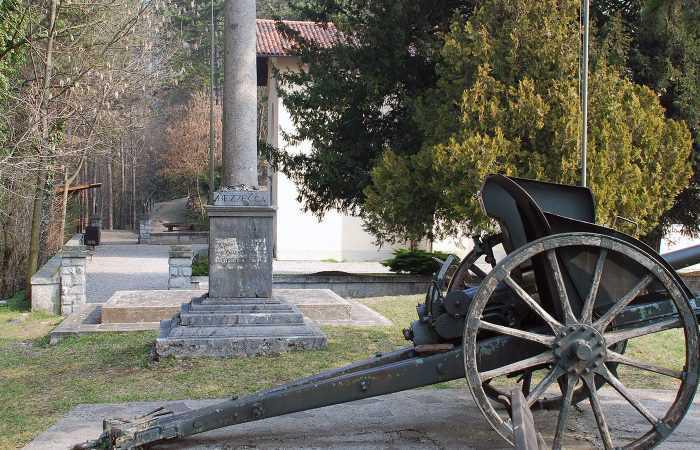Ossario Garibaldino e della Grande Guerra del Colle S. Stefano
31 Via Giacomo Cis Bezzecca
IT EN DE
Se dal Museo della Grande Guerra ci si sposta nella piazza del paese si può trovare la lapide di Giovanni Chiassi, garibaldino caduto in battaglia. La tradizione popolare vuole che, essendo stato luogo dei fatti d’armi del 1866, sia partito proprio dalla piazza il famoso “obbedisco” detto da Giuseppe Garibaldi.
La salita per il colle può avvenire per 3 percorsi, il primo attraverso la galleria “la Marmora” dove i soldati tenevano le scorte salendo per una scala a chiocciola da 82 gradini, il secondo costeggiando la galleria con una scalinata esterna mentre il terzo si può percorrere in macchina salendo da via Santo Stefano per arrivare al parcheggio del cimitero.
Sulla cima del colle si trova la Chiesa dei santi Stefano e Lorenzo dove sono posti i caduti in guerra del 1866 e della Grande Guerra diventato così monumento Ossario nel 1931; al suo interno oltre ad alcuni cimeli si può trovare il “ Monumento al Fante caduto” .
A destra della chiesa sopra all’uscita della scala a chiocciola si vede un cannone risalente alla prima guerra mondiale da 75 millimetri.
A sinistra della chiesa invece si possono percorrere le trincee scavate dai soldati italiani per il controllo delle incursioni da parte degli austro ungarici, sono tutt’oggi tenute in ottimo stato e ben segnalate.
Al vertice del colle, collegata da camminamenti e gallerie che si intersecano tra loro, troviamo una grossa croce di marmo bianco in ricordo dei caduti sia italiani che austriaci della Battaglia di Bezzecca.
IT EN DE
In Bezzecca’s town square is placed the tombstone of Giovanni Chiassi, a Garibaldian who fell in battle. Popular tradition has it that, having been the site of the military feats of 1866, the famous "I obey" said by Giuseppe Garibaldi started right from the square.
The ascent to Colle Santo Stefano can take place by 3 routes, the first through the "la Marmora" gallery,where the soldiers kept supplies, by climbing a spiral staircase with 82 steps, the second skirting the gallery with an external staircase while the third can be drive up from via Santo Stefano to get to the cemetery parking lot.
On the top of the hill is the Church of Sains Stefano and Lorenzo where the war dead of 1866 and of the Great War are placed, thus becoming an ossuary monument in 1931; inside, in addition to some memorabilia, you can find the " Monument to the Fallen Infantryman".
To the right of the church above the exit of the spiral staircase you can see a 75mm cannon dating back to the First World War.
To the left of the church you can walk through the trenches dug by the Italian soldiers to reject the incursions by the Austro-Hungarians. They are still kept in excellent condition and well signposted.
At the top of the hill, connected by intersecting walkways and tunnels, stands a large white marble cross in memory of both the Italian and Austrian fallen in the Battle of Bezzecca.
IT EN DE
Auf dem Stadtplatz von Bezzecca steht der Grabstein von Giovanni Chiassi, einem Garibaldi, der in der Schlacht gefallen ist. Der Volksglaube besagt, dass das berühmte "Ich gehorche" von Giuseppe Garibaldi direkt von diesem Platz ausging, da er der Ort der militärischen Heldentaten von 1866 war.
Der Aufstieg zum Colle Santo Stefano kann auf drei Wegen erfolgen: der erste führt über die Galerie "la Marmora", in der die Soldaten ihre Vorräte aufbewahrten, über eine Wendeltreppe mit 82 Stufen, der zweite führt über eine Außentreppe an der Galerie vorbei, während der dritte Weg von der Via Santo Stefano zum Parkplatz des Friedhofs führt.
Auf der Spitze des Hügels befindet sich die Kirche Sainte Stefano e Lorenzo, in der die Kriegstoten von 1866 und des Ersten Weltkriegs beigesetzt sind, die 1931 zu einem Beinhaus wurden; im Inneren befindet sich neben einigen Erinnerungsstücken das "Denkmal für den gefallenen Infanteristen".
Auf der rechten Seite der Kirche, über dem Ausgang der Wendeltreppe, befindet sich eine 75-mm-Kanone aus dem Ersten Weltkrieg.
Links von der Kirche kann man durch die Schützengräben gehen, die von den italienischen Soldaten ausgehoben wurden, um die Angriffe der Österreich-Ungarn abzuwehren. Sie sind noch immer in ausgezeichnetem Zustand und gut ausgeschildert.
Auf dem Gipfel des Hügels, der durch sich kreuzende Gänge und Tunnel verbunden ist, steht ein großes weißes Marmorkreuz zum Gedenken an die italienischen und österreichischen Gefallenen der Schlacht von Bezzecca.

